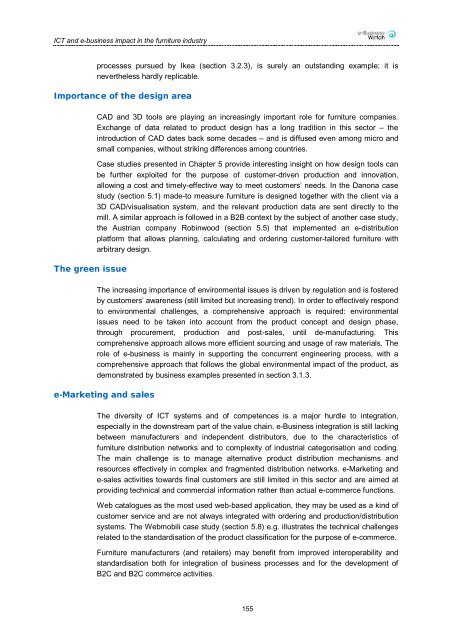ICT and e-Business Impact in the Furniture Industry - empirica
ICT and e-Business Impact in the Furniture Industry - empirica
ICT and e-Business Impact in the Furniture Industry - empirica
- No tags were found...
Create successful ePaper yourself
Turn your PDF publications into a flip-book with our unique Google optimized e-Paper software.
<strong>ICT</strong> <strong>and</strong> e-bus<strong>in</strong>ess impact <strong>in</strong> <strong>the</strong> furniture <strong>in</strong>dustryprocesses pursued by Ikea (section 3.2.3), is surely an outst<strong>and</strong><strong>in</strong>g example; it isnever<strong>the</strong>less hardly replicable.Importance of <strong>the</strong> design areaThe green issueCAD <strong>and</strong> 3D tools are play<strong>in</strong>g an <strong>in</strong>creas<strong>in</strong>gly important role for furniture companies.Exchange of data related to product design has a long tradition <strong>in</strong> this sector – <strong>the</strong><strong>in</strong>troduction of CAD dates back some decades – <strong>and</strong> is diffused even among micro <strong>and</strong>small companies, without strik<strong>in</strong>g differences among countries.Case studies presented <strong>in</strong> Chapter 5 provide <strong>in</strong>terest<strong>in</strong>g <strong>in</strong>sight on how design tools canbe fur<strong>the</strong>r exploited for <strong>the</strong> purpose of customer-driven production <strong>and</strong> <strong>in</strong>novation,allow<strong>in</strong>g a cost <strong>and</strong> timely-effective way to meet customers’ needs. In <strong>the</strong> Danona casestudy (section 5.1) made-to measure furniture is designed toge<strong>the</strong>r with <strong>the</strong> client via a3D CAD/visualisation system, <strong>and</strong> <strong>the</strong> relevant production data are sent directly to <strong>the</strong>mill. A similar approach is followed <strong>in</strong> a B2B context by <strong>the</strong> subject of ano<strong>the</strong>r case study,<strong>the</strong> Austrian company Rob<strong>in</strong>wood (section 5.5) that implemented an e-distributionplatform that allows plann<strong>in</strong>g, calculat<strong>in</strong>g <strong>and</strong> order<strong>in</strong>g customer-tailored furniture witharbitrary design.The <strong>in</strong>creas<strong>in</strong>g importance of environmental issues is driven by regulation <strong>and</strong> is fosteredby customers’ awareness (still limited but <strong>in</strong>creas<strong>in</strong>g trend). In order to effectively respondto environmental challenges, a comprehensive approach is required: environmentalissues need to be taken <strong>in</strong>to account from <strong>the</strong> product concept <strong>and</strong> design phase,through procurement, production <strong>and</strong> post-sales, until de-manufactur<strong>in</strong>g. Thiscomprehensive approach allows more efficient sourc<strong>in</strong>g <strong>and</strong> usage of raw materials. Therole of e-bus<strong>in</strong>ess is ma<strong>in</strong>ly <strong>in</strong> support<strong>in</strong>g <strong>the</strong> concurrent eng<strong>in</strong>eer<strong>in</strong>g process, with acomprehensive approach that follows <strong>the</strong> global environmental impact of <strong>the</strong> product, asdemonstrated by bus<strong>in</strong>ess examples presented <strong>in</strong> section 3.1.3.e-Market<strong>in</strong>g <strong>and</strong> salesThe diversity of <strong>ICT</strong> systems <strong>and</strong> of competences is a major hurdle to <strong>in</strong>tegration,especially <strong>in</strong> <strong>the</strong> downstream part of <strong>the</strong> value cha<strong>in</strong>. e-<strong>Bus<strong>in</strong>ess</strong> <strong>in</strong>tegration is still lack<strong>in</strong>gbetween manufacturers <strong>and</strong> <strong>in</strong>dependent distributors, due to <strong>the</strong> characteristics offurniture distribution networks <strong>and</strong> to complexity of <strong>in</strong>dustrial categorisation <strong>and</strong> cod<strong>in</strong>g.The ma<strong>in</strong> challenge is to manage alternative product distribution mechanisms <strong>and</strong>resources effectively <strong>in</strong> complex <strong>and</strong> fragmented distribution networks. e-Market<strong>in</strong>g <strong>and</strong>e-sales activities towards f<strong>in</strong>al customers are still limited <strong>in</strong> this sector <strong>and</strong> are aimed atprovid<strong>in</strong>g technical <strong>and</strong> commercial <strong>in</strong>formation ra<strong>the</strong>r than actual e-commerce functions.Web catalogues as <strong>the</strong> most used web-based application, <strong>the</strong>y may be used as a k<strong>in</strong>d ofcustomer service <strong>and</strong> are not always <strong>in</strong>tegrated with order<strong>in</strong>g <strong>and</strong> production/distributionsystems. The Webmobili case study (section 5.8) e.g. illustrates <strong>the</strong> technical challengesrelated to <strong>the</strong> st<strong>and</strong>ardisation of <strong>the</strong> product classification for <strong>the</strong> purpose of e-commerce.<strong>Furniture</strong> manufacturers (<strong>and</strong> retailers) may benefit from improved <strong>in</strong>teroperability <strong>and</strong>st<strong>and</strong>ardisation both for <strong>in</strong>tegration of bus<strong>in</strong>ess processes <strong>and</strong> for <strong>the</strong> development ofB2C <strong>and</strong> B2C commerce activities.155
















